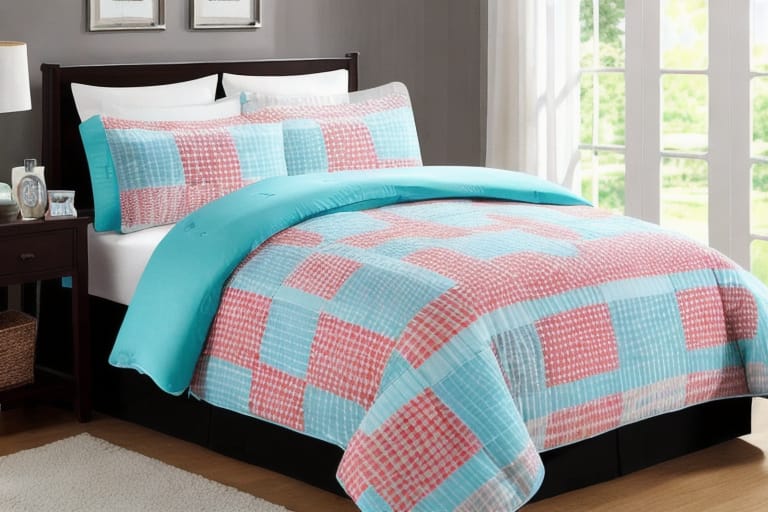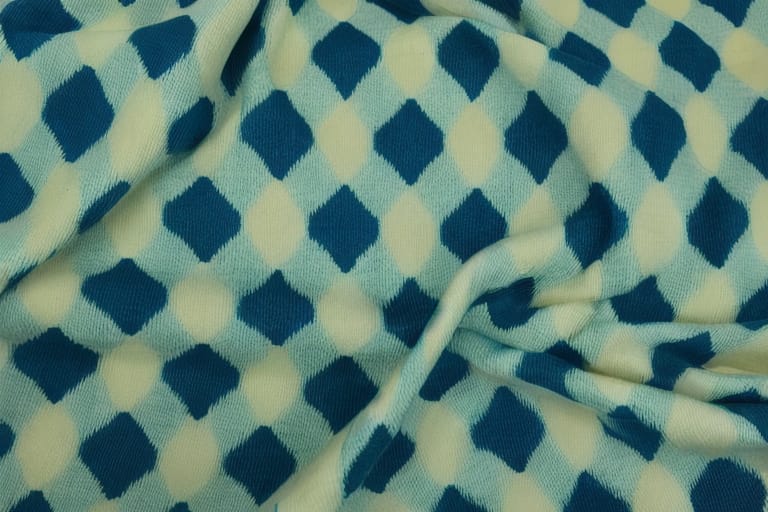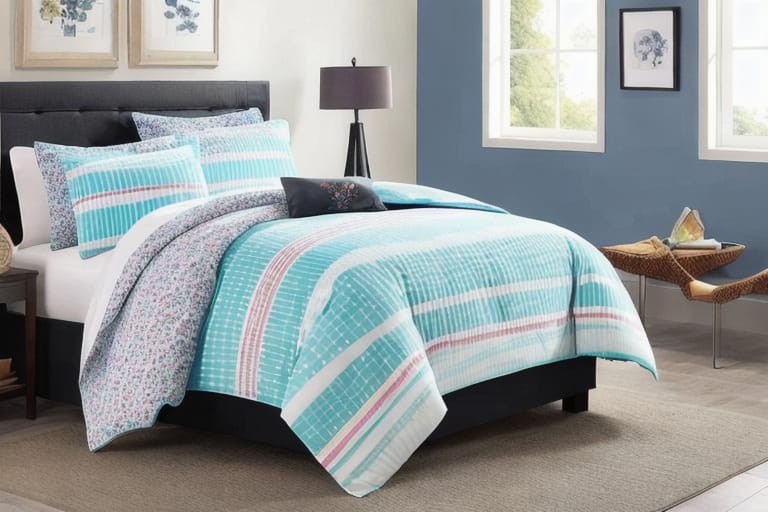Are you looking to add a plush, cozy comforter to your bedroom? Down fiber comforters are a top choice for their unmatched warmth, softness, and durability. This guide will walk you through everything you need to know about these luxurious bed covers from fill power to thread count.
What are Down Comforters?
A down comforter is filled with the fine, fluffy clusters and plumules that insulate birds and waterfowl. This natural down filling provides lightweight, breathable warmth that lofts up thick and puffy inside the comforter.
The most common materials used are:
- Goose down – Very soft, long-lasting, and warm
- Duck down – Affordable option with good warmth
- Feathers – Adds loft and support
When shopping for a down comforter, the first thing to look for is the fill power, which measures the loft and insulation. Higher fill power between 600 and 900 results in the most plush, breathable comforters that won’t flatten easily.
Benefits of Down in Comforters
- Exceptional warmth – Down clusters trap body heat efficiently
- Lightweight – Less filling required compared to other insulators
- Softness – Smooth, fluffy texture for luxurious feel
- Durability – Resilient clusters maintain loft for years
- Breathability – Allows ventilation to prevent overheating
- Compressibility – Packs down small and regains fullness
Down vs. Down Alternative Comforters
For those with allergies or seeking other options, down alternative comforters offer similar plush comfort with hypoallergenic synthetic fills made from:
- PrimaLoft® – Microfiber with properties mimicking down
- Polyester – Budget option lacking in warmth and softness
Comparison of Down and Down Alternative Comforters
| Feature | Down | Down Alternative |
|---|---|---|
| Fill Material | Natural down and feathers | PrimaLoft® or polyester |
| Warmth | Excellent | Good |
| Softness | Exceptional loft and cushion | Varies depending on material |
| Durability | 10+ years if cared for | 5-6 years typical |
| Allergies | Contains allergens | Hypoallergenic |
| Odor | Natural, none with covers | Some synthetic smell |
| Cost |
While less expensive and hypoallergenic, down alternative comforters tend to be less durable and breathable. The synthetic fills also lack the cloud-like softness of high quality down.
Inside the Shell: Components of a Down Comforter
Beyond the fill power and materials, comforters are also defined by their:
- Shell fabric – High thread count cotton, Egyptian cotton, cotton sateen, silk, etc. The tighter the weave of natural fibers, the better the breathability.
- Fill weight – Measured in ounces (oz), more down translates to more warmth. Choose based on your climate and seasons.
- Construction – A baffle box design contains down in compartments, while sewn-through prevents shifting of fill.
- Features – Consider corner loops for duvet anchoring and reinforced seams for durability.
Pay attention to the density or thread count of the shell fabric. High-end comforters may have 400+ thread count cotton or even 1000 thread count Egyptian cotton shells – adding strength, softness and promoting ventilation.

All-Season vs. Winter Down Comforters
The cozy warmth of down makes it suitable year-round for many sleepers based on your climate and sleeping preferences like room temperature. Look at the fill weight and materials to determine the best uses:
Year Round Down Comforters
- 700+ fill power down
- Lightweight shell
- Fill weight from 15 oz to 29 oz
- Breathable for air circulation
- Adaptable warmth for multi-season use
Heavy Winter Down Comforters
- Fill weight 30 oz and above
- Warmer shell fabric with higher thread count
- Fill power of 600 to 800
- Maximized insulation for frigid weather
Adjustable corner loops allow you to anchor a duvet cover so the comforter stays neatly in place all year without shifting.
Special Considerations for Allergy Sufferers
To avoid allergic reactions, look for comforters with these hypoallergenic properties:
- RDS Certification – Responsible Down Standard ensures ethical treatment of birds.
- DOWNPROOF® Cotton – Tight 400+ thread count pima cotton blocks dust and particles.
- Quality Materials – Less likely to leak feathers than lower grade products.
- Barrier Weave Covers – Add duvet with allergen blocking could provide extra protection.
Proper care like regular laundering also reduces dust and allergens. Or opt for the synthetic fills found in down alternative comforters specifically designed to minimize allergic reactions.
Construction for Durability and Warmth
How a down comforter is assembled impacts its longevity, fill distribution, and insulation capabilities:
Baffle box construction
- Separates filling into compartments
- Uniform thickness maintains maximum loft
- Sturdier structure keeps fill evenly distributed
- Best warmth retention from no shifting
Sewn-through construction
- Down filling is stitched through front and back
- Warmer with more fill making direct contact
- Can result in cold spots from shifting fill
- Collapses quicker under body weight
For the highest quality and durability over many years, pay close attention to reinforced double needle stitching and strong seam work so the comforter retains shape.
Caring Properly for a Down Comforter
Follow these care tips to enhance performance and extend a down comforter’s lifespan to 10-15 years:
- Professional laundering is recommended every 2-3 years
- Home washing once per year in commercial machines
- Gentle cycles with mild detergent to prevent damage
- Air/line dry completely since heat ruins down
- Use a duvet cover to protect from bodily oils
- Practice proper storage folded or hanging loosely
With the right care, a quality down comforter will continue insulating your bed in pillowy comfort for over a decade.

Leading Brands Craft Luxe Down Comforters
Reputable manufacturers and retailers offering excellent down comforters include:
Lands’ End Down Comforters
- 600 to 700 fill power
- PrimaLoft synthetic options
- Zip-off cover included for cleaning
- Sleep Trial and guarantee
The Company Store Down Comforters
- Legends® Hotel 650 fill power white down
- 300-500 thread count cotton
- Exceptional longevity
- Lifetime guarantee
Brooklinen Down Comforters
- 700 fill power responsibly sourced down
- Long staple cotton with 380 thread count
- Lightweight and all-season offerings
- Oeko-Tex certified for chemical safety
Snowe Down Comforters
- 700 fill power European down
- 300 thread count sateen cotton shell
- Sewn-through box construction
- Mid-weight for sleeping comfort
Finding the perfect comforter is easier when you understand what makes these bedding essentials so soft, breathable and deliciously warm. Use this guide to pick out a quality down comforter to cosy up with for years of blissful nights.
Frequently Asked Questions
What is the benefit of baffle box construction in a down comforter?
Baffle box construction contains the down filling in separated compartments or “baffle boxes” to prevent shifting around. This allows for consistent loft and less cold spots. The sturdy structure also enables better warmth retention.
How do I know what fill weight I need in my climate?
Check the fill weight or amount of down filling inside the comforter, measured in ounces. Lightweights range from 15-22 oz for hotter climates, while 30 oz and higher suits cold regions. The right amount translates to better breathability and temperature regulation in your location.
What thread count should I look for in a down comforter?
Higher cotton thread counts between 400-500 plus tightly woven Egyptian Cotton shells allow enhanced breathability for better comfort. But balances softness too – over 600 thread count can feel too stiff. High quality materials also promote durability.
Can I wash a down comforter at home?
Home washing is possible but take precautions like using commercial washers, gentle cycles, and mild detergents to prevent damage. Always completely air dry since heat degrades delicate down fiber filling. To extend lifespan, professional laundering every 2-3 years is best over home washing.
How long does a quality down comforter last?
With the proper initial quality, care and maintenance, you can enjoy a down comforter for approximately 10 to 15 years before losing significant loft or warmth. Higher price points provide better durability from reinforced stitching, premium shell fabrics and responsibly sourced fill materials.








